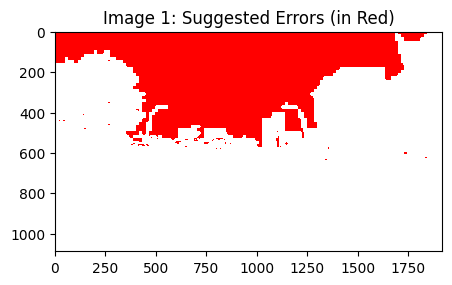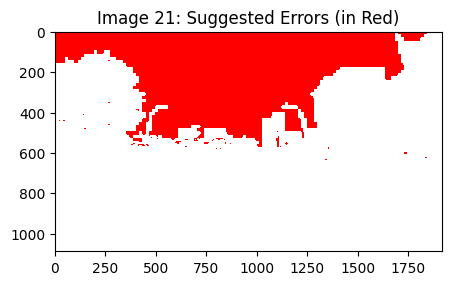Find Label Errors in Semantic Segmentation Datasets#
This 5-minute quickstart tutorial shows how you can use cleanlab to find potentially mislabeled images in semantic segmentation datasets. In semantic segmentation, our data consists of images each annotated with a corresponding mask that labels each pixel in the image as one of K classes. Models are trained on this labeled mask to predict the class of each pixel in an image. However in real-world data, this annotated mask often contains errors. Here we apply cleanlab to find label errors in a variant of the SYNTHIA segmentation dataset, which consists of synthetic images generated via graphics engine.
Quickstart
cleanlab uses two inputs to handle semantic segmentation data classification data: - labels: Array of dimension (N,H,W) where N is the number of images and H and W are dimension of the image. We assume an integer encoded image. For one-hot encoding one can np.argmax(labels_one_hot,axis=1) assuming that labels_one_hot is of dimension (N,K,H,W) where K is the number of classes. - pred_probs: Array of dimension (N,K,H,W), similar to labels.
With these inputs, you can find and review label issues via this code:
from cleanlab.segmentation.filter import find_label_issues
from cleanlab.segmentation.summary import display_issues
issues = find_label_issues(labels, pred_probs)
display_issues(issues, pred_probs=pred_probs, labels=labels,
top=10)
1. Install required dependencies and download data#
You can use pip to install all packages required for this tutorial as follows:
!pip install cleanlab
[1]:
%%capture
!wget -nc 'https://cleanlab-public.s3.amazonaws.com/ImageSegmentation/given_masks.npy'
[2]:
%%capture
!wget -nc 'https://cleanlab-public.s3.amazonaws.com/ImageSegmentation/predicted_masks.npy'
[4]:
import numpy as np
from cleanlab.segmentation.filter import find_label_issues
from cleanlab.segmentation.rank import get_label_quality_scores, issues_from_scores
from cleanlab.segmentation.summary import display_issues, common_label_issues, filter_by_class
np.set_printoptions(suppress=True)
2. Get data, labels, and pred_probs#
This tutorial just loads labels and pred_probs for our dataset, which are the only inputs required to find label issues and score the label quality of each image with cleanlab. For your own dataset, you will need to properly format its labels and train your own semantic segmentation model to produce pred_probs (pixel-level predicted class probabilities, which should be out-of-sample such as computed via cross-validation). Our example training
notebook demonstrates code to train a Pytorch segmentation model on the SYNTHIA dataset, produce such pred_probs for each image, and save them in a .npy file (which we simply load in this tutorial via np.load).
Here’s what an image looks like in the SYNTHIA dataset. For every image there is a label mask provided in which each pixel is integer-encoded as one of the SYNTHIA classes: sky, building, road, sidewalk, fence, vegetation, pole, car, traffic sign, person, bicycle, motorcycle, traffic light, terrain, rider, truck, bus, train, wall, and unlabeled (annotated for pixels not belonging to the other classes).
In semantic segmentation tasks labels and pred_probs are formatted with the following dimensions:
N - Number of images in the dataset
K - Number of classes in the dataset
H - Height of each image
W - Width of each image
Each pixel in the dataset is labeled with one of K possible classes. The pred_probs contain a length-K vector for each pixel in the dataset (which sums to 1 for each pixel). This results in an array of size (N,K,H,W).
Note that cleanlab requires only pred_probs from any trained segmentation model and labels in order to detect label errors. The pred_probs should be out-of-sample, which can be obtained for every image in a dataset via K-fold cross-validation.
pred_probs dim: (N,K,H,W)
[5]:
pred_probs_filepaths ='predicted_masks.npy'
pred_probs = np.load(pred_probs_filepaths, mmap_mode='r+')
print(pred_probs.shape)
(30, 20, 1088, 1920)
The labels contain a class label for each pixel in each image, which must be an integer in 0, 1, ..., K-1. This results in an array of size (N,H,W).
labels dim: (N,H,W)
[6]:
label_filepaths ='given_masks.npy'
labels = np.load(label_filepaths, mmap_mode='r+')
print(labels.shape)
(30, 1088, 1920)
Note that these correspond to the labeled mask from the dataset, and the extracted probabilities of a trained classifier. If using your own dataset, which may consider iterating on memmaped numpy arrays.
labels: Array of dimension (N,H,W) where N is the number of images, K is the number of classes, and H and W are dimension of the image. We assume an integer encoded image. For one-hot encoding one cannp.argmax(labels_one_hot,axis=1)assuming thatlabels_one_hotis of dimension (N,K,H,W)pred_probs: Array of dimension (N,K,H,W), similar tolabelswhereKis the number of classes.
class_names dim: (K,)
Some of our functions optionally use the class names to improve visualization. Here are the class names in our dataset.
[7]:
SYNTHIA_CLASSES = ['unlabeled','sky', 'building', 'road', 'sidewalk', 'fence', 'vegetation','pole','car', \
'traffic sign','person','bicycle','motorcycle','traffic light', 'terrain', \
'rider', 'truck', 'bus', 'train','wall']
3. Use cleanlab to find label issues#
In segmentation, we consider an image mislabeled if the given mask does not match what truly appears in the image that is being segmented. More specifically, when a pixel is labeled as class i but the pixel really belongs to class j. This generally happens when an image is annotated maunally by human annotators.
Below are examples of three types of annotation errors common in segmentation datasets.
Based on the given labels and out-of-sample pred_probs, cleanlab can quickly help us identify such label issues in our dataset by calling find_label_issues().
By default, the indices of the identified label issues are sorted by cleanlab’s self-confidence score, which measures the quality of each given label via the probability assigned to it by our trained model. The returned issues is a boolean mask of dimension (N,H,W), where True corresponds to a detected error sorted by image quality with the lowest-quality images coming first.
[8]:
issues = find_label_issues(labels, pred_probs,downsample = 16, n_jobs=None, batch_size=100000)
Total number of examples whose labels have been evaluated: 244800
Note: - The downsample flag gives us compute benefits to scale to large datasets, but for maximum label error detection accuracy, keep this value low. - To maximize compute efficiency, try to use the largest batch_size your system memory allows.
Visualize top label issues#
Let’s look at the top 2 images that cleanlab thinks are most likely mislabeled, namely images located at index 131 and 29. The part of image highlighted in red is where cleanlab believes the given mask does not match what really appears in the image.
[9]:
display_issues(issues,top=2)


We can also input pred_probs, labels, and class_names as auxiliary inputs to see more information.
[10]:
display_issues(issues, labels=labels, pred_probs=pred_probs, class_names=SYNTHIA_CLASSES,top=2)



After additionally inputting pred_probs, labels, and class_names we see more information: - Inputs labels and pred_probs generates the first two columns. This segments the image based on the class that appears in the given label and what class the model predicted for those pixels. - Input class_names creates the legend that color codes our segmentation.
In the leftmost plot we can see that the dark brown area (the unlabeled class as shown in the legend) was the given label. The middle plot shows our model believes that this area is infact the sky, a light brown shade in the legend. The rightmost plot highlights the discrepancy between these classes in red to indicate which area of the image is likely mislabeled.
These plots clearly highlight the part of the sky that was mislabeled by annotators of this image.
Classes which are commonly mislabeled overall#
We may also wish to understand which classes tend to be most commonly mislabeled throughout the entire dataset by calling common_label_issues().
[11]:
common_label_issues(issues, labels=labels, pred_probs=pred_probs, class_names=SYNTHIA_CLASSES)
Class 'unlabeled' is potentially mislabeled as class for 'sky' 3263230 pixels in the dataset
Class 'unlabeled' is potentially mislabeled as class for 'car' 783381 pixels in the dataset
Class 'pole' is potentially mislabeled as class for 'building' 275110 pixels in the dataset
Class 'unlabeled' is potentially mislabeled as class for 'building' 255917 pixels in the dataset
Class 'traffic light' is potentially mislabeled as class for 'building' 78225 pixels in the dataset
Class 'person' is potentially mislabeled as class for 'building' 55990 pixels in the dataset
Class 'unlabeled' is potentially mislabeled as class for 'sidewalk' 54315 pixels in the dataset
Class 'pole' is potentially mislabeled as class for 'sidewalk' 33591 pixels in the dataset
Class 'building' is potentially mislabeled as class for 'car' 24645 pixels in the dataset
Class 'wall' is potentially mislabeled as class for 'building' 21054 pixels in the dataset
Class 'person' is potentially mislabeled as class for 'sidewalk' 15045 pixels in the dataset
Class 'wall' is potentially mislabeled as class for 'sidewalk' 14171 pixels in the dataset
Class 'building' is potentially mislabeled as class for 'sky' 13832 pixels in the dataset
Class 'road' is potentially mislabeled as class for 'car' 13498 pixels in the dataset
Class 'fence' is potentially mislabeled as class for 'building' 11490 pixels in the dataset
Class 'car' is potentially mislabeled as class for 'road' 9164 pixels in the dataset
Class 'car' is potentially mislabeled as class for 'building' 8769 pixels in the dataset
Class 'wall' is potentially mislabeled as class for 'vegetation' 6999 pixels in the dataset
Class 'wall' is potentially mislabeled as class for 'car' 6031 pixels in the dataset
Class 'traffic sign' is potentially mislabeled as class for 'building' 5011 pixels in the dataset
[11]:
| given_label | predicted_label | num_pixel_issues | |
|---|---|---|---|
| 0 | unlabeled | sky | 3263230 |
| 1 | unlabeled | car | 783381 |
| 2 | pole | building | 275110 |
| 3 | unlabeled | building | 255917 |
| 4 | traffic light | building | 78225 |
| 5 | person | building | 55990 |
| 6 | unlabeled | sidewalk | 54315 |
| 7 | pole | sidewalk | 33591 |
| 8 | building | car | 24645 |
| 9 | wall | building | 21054 |
| 10 | person | sidewalk | 15045 |
| 11 | wall | sidewalk | 14171 |
| 12 | building | sky | 13832 |
| 13 | road | car | 13498 |
| 14 | fence | building | 11490 |
| 15 | car | road | 9164 |
| 16 | car | building | 8769 |
| 17 | wall | vegetation | 6999 |
| 18 | wall | car | 6031 |
| 19 | traffic sign | building | 5011 |
The printed information above is also stored in a returned pandas DataFrame, which summarizes which classes are overall least reliably labeled in the dataset.
Focusing on one specific class#
We can also just focus on issues within a specific class of interest, say just the class car. Easily do so using filter_by_class to only look at the estimated label errors in the car class. Here the color-coding reveals that the pixels depicting a car in the image were mistakenly left as the unlabeled class in the given label.
[12]:
class_issues = filter_by_class(SYNTHIA_CLASSES.index("car"), issues,labels=labels, pred_probs=pred_probs)
[13]:
display_issues(class_issues, pred_probs=pred_probs, labels=labels, top=3, class_names=SYNTHIA_CLASSES)




Get label quality scores#
Cleanlab can provide an overall label quality score for each image to estimate our confidence that it is correctly labeled. These scores range from 0 to 1, such that lower scores indicate images more likely to contain some mislabeled pixels.
Note: To automatically estimate which pixels are mislabeled (and the number of label errors) rather than ranking the images, use find_label_issues() instead.
The label quality scores are most useful if you only have time to review a limited number of images and want to prioritize which ones to look at, or if you’re specifically aiming to detect label errors with high precision (or high recall) rather than overall estimation of the set of mislabeled images and pixels.
[14]:
image_scores, pixel_scores = get_label_quality_scores(labels, pred_probs)
Beyond scoring the overall label quality of each image, the above method produces a (0 to 1) quality score for each pixel. We can apply a thresholding function to these scores in order to extract the same style True or False mask as find_label_issues().
[15]:
issues_from_score = issues_from_scores(image_scores, pixel_scores, threshold=0.5)
[16]:
display_issues(issues_from_score, pred_probs=pred_probs, labels=labels, top=5)





We can see that the errors are dominated by label errors in the sky.